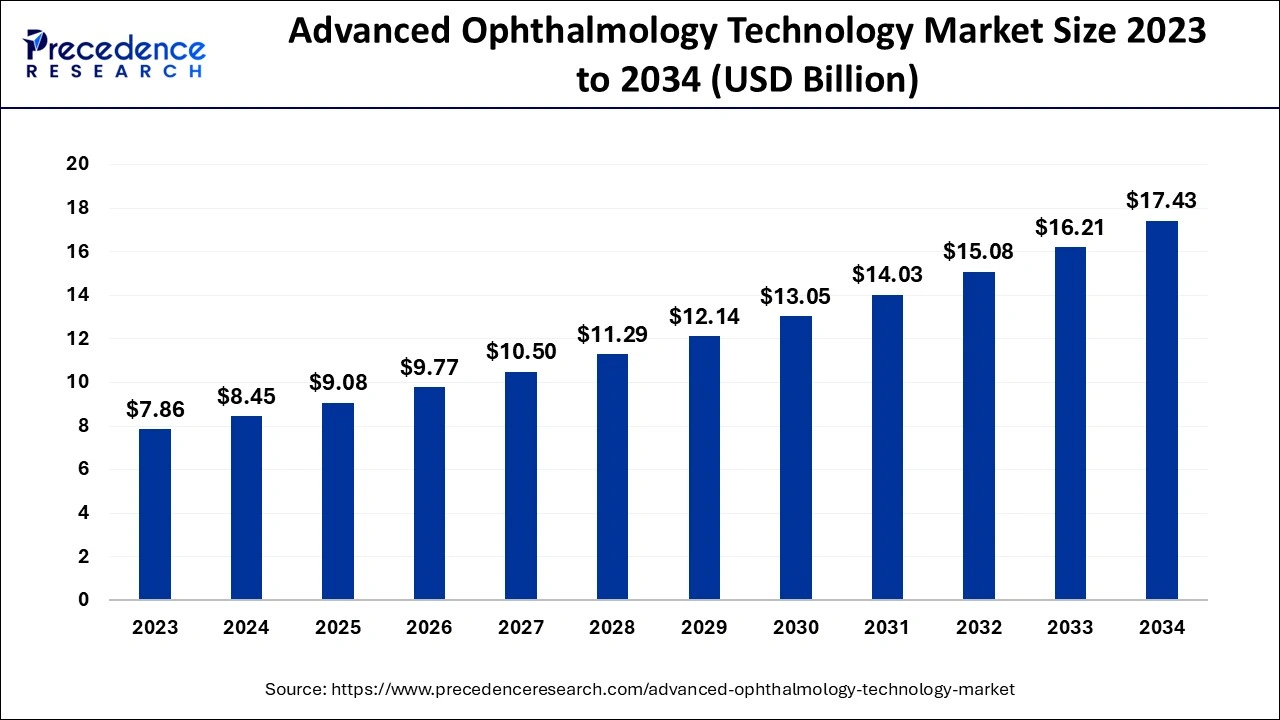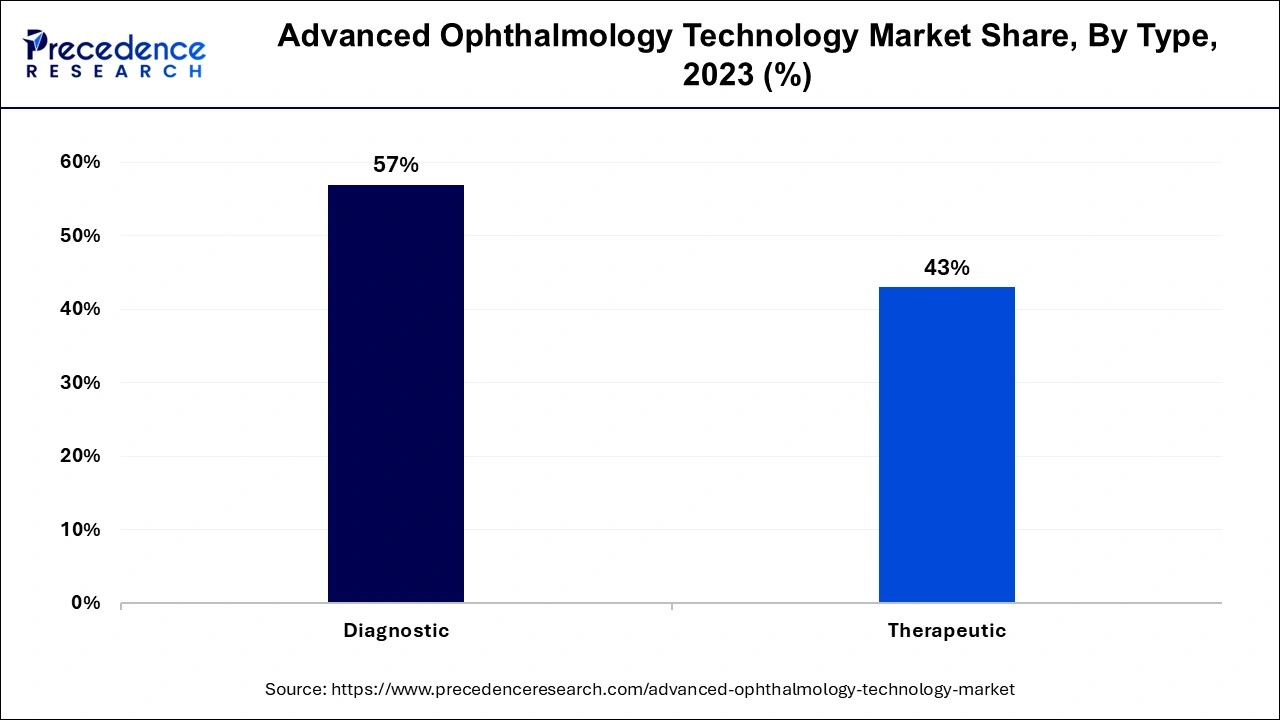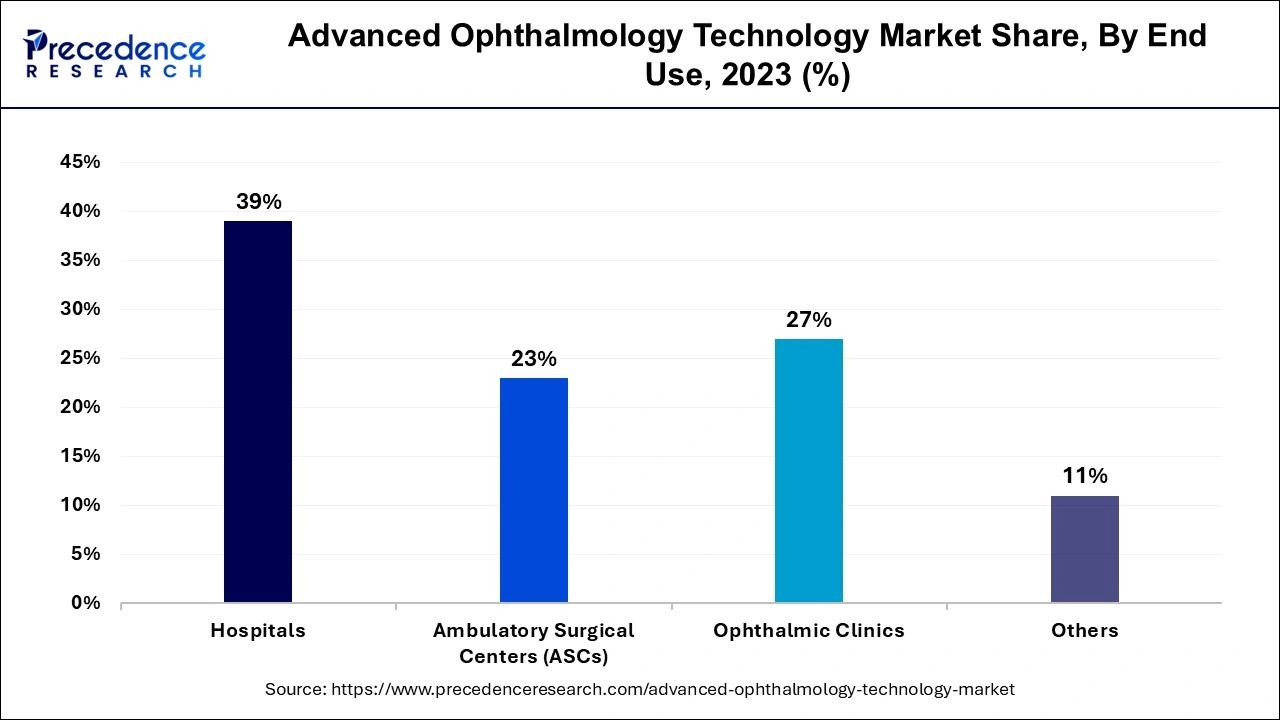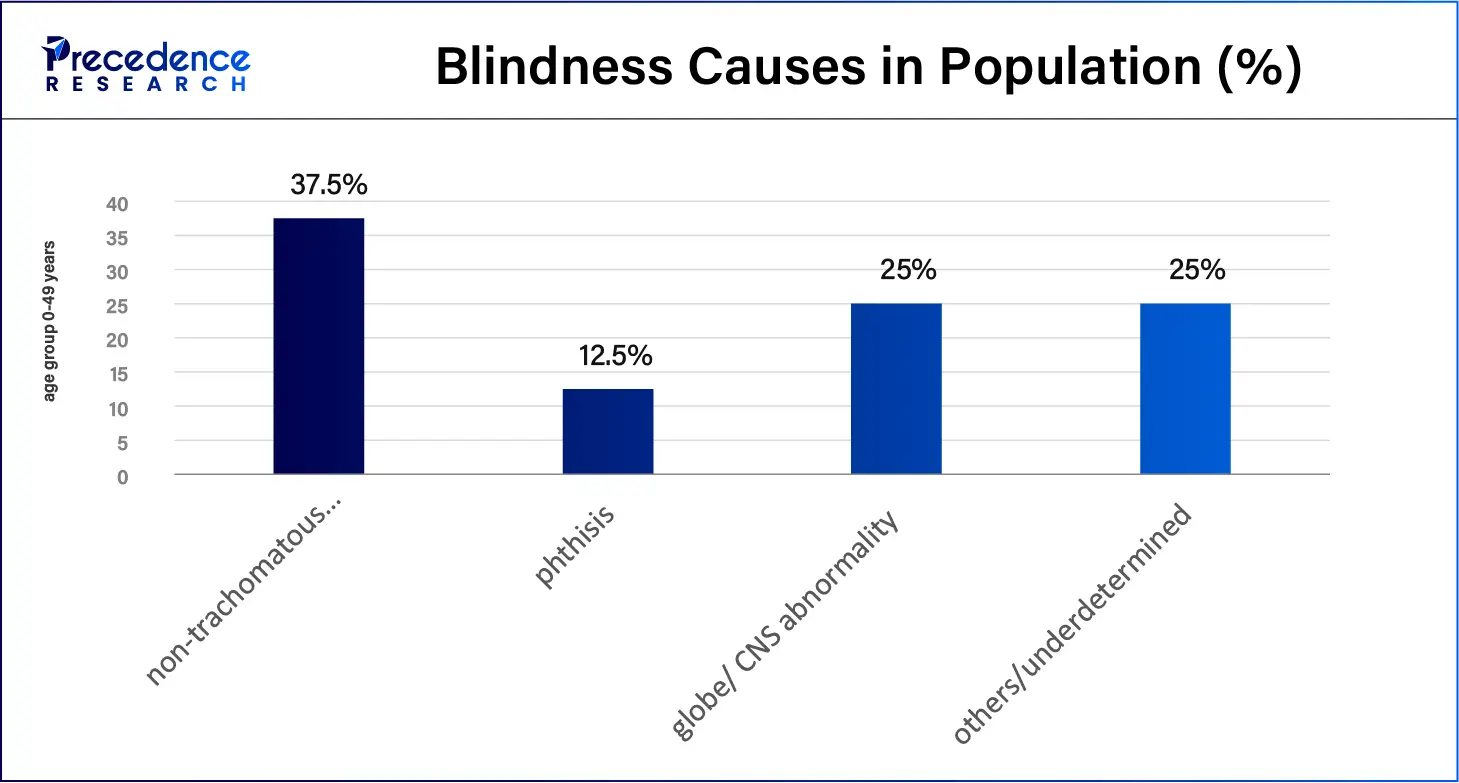List of Contents
What is the Advanced Ophthalmology Technology Market Size?
The global advanced ophthalmology technology mmarket size is calculated at USD 9.08 billion in 2025 and is predicted to increase from USD 9.77 billion in 2026 to approximately USD 17.43 billion by 2034, expanding at a CAGR of 7.51% from 2025 to 2034.The rising cases of eye infection and eye disease in the population due to the aging effect and environmental conditions are driving the growth of the advanced ophthalmology technology market.

Advanced Ophthalmology Technology Market Key Takeaways
- The global advanced ophthalmology technology market was valued at USD 8.45 billion in 2024.
- It is projected to reach USD 17.43 billion by 2034.
- The advanced ophthalmology technology market is expected to grow at a CAGR of 7.51% from 2025 to 2034.
- North America dominated the advanced ophthalmology technology market with the highest market share of 38% in 2024.
- Asia Pacific expected the grow at a fastest CAGR of 7.72% during the forecast period.
- By type, the diagnostics segment accounted for the biggest market share of 57% in 2024.
- By type, the therapeutic segment is expected to expand at a notable CAGR of 7.52% during the forecast period.
- By end use, the hospital segment contributed the highest market share of 39% in 2024.
- By end use, the ASCs (Ambulatory Surgery Centers) segment is projected to grow at a solid CAGR of 7.72% during the forecast period.
Market Overview
Ophthalmology is the study of the treatment of eye-related diseases. In the human body, the eye is one of the smallest and most delicate organs that requires specialized equipment for detecting and diagnostics. The ongoing technological evaluation in ophthalmology is driving the advancement in the equipment or the devices that help in the diagnostics of the eye, including objectives, lenses, ultrasound, cameras, laser, infrared sensors, and others. With the evaluation of technology, ophthalmology also uses smart innovations in technology such as virtual reality, 3D imaging, big data, artificial intelligence (AI), and others. The advanced ophthalmology technology consists of surgical instruments, lasers, and advancements in biotechnology that are used to provide enhanced accuracy and precision in treatment, further driving the growth of the advanced ophthalmology technology market.
How Can AI Impact the Advanced Ophthalmology Technology Market?
The evaluation of AI in healthcare and other fields or actions is truly revolutionizing the entire work environment of the industry. AI enables automated diagnostics and imaging, though it can help detect or predict the disease course. In the area of ophthalmology, artificial intelligence is being heavily explored for the detection, treatment, and surveillance of several diseases. AI is being used in several ophthalmology fields, including glaucoma, diabetic retinopathy, age-related macular degeneration, retinal vascular occlusions, retinopathy of prematurity, cataract, keratoconus refractive errors, squint, retinal detachment, and ocular cancers.
- In October 2024, ZEISS Medical Technology launched the new digital AI tools and 'revolutionary' new surgical solutions at the conference of the American Academy of Ophthalmology (AAO) held in Chicago, United States.
Advanced Ophthalmology Technology Market Trends
- Refractive errors and cataracts are the major cause of vision impairment and blindness at a global level. Globally, there are 2.2 billion people suffering from distance and near vision impairment which the 1 billion could have been prevented or to be addressed. Vision impairment possesses the annual global cost of production expected to be US$ 411 billion.
- Among the 1 billion people, the major causes of distance vision impairment or blindness are refractive error (88.4 million), cataracts (94 million), glaucoma (7.7 million), and age-related macular degeneration (8 million), diabetic retinopathy (3.9 million).
Advanced Ophthalmology Technology Market Growth Factors
- Rising geriatric population: The rise in the geriatric population and the rising cases of eye-related diseases such as age-related eye disease, which causes the demand for an effective treatment process, is driving the demand for ophthalmology treatment.
- Rising number of eye diseases: The rise in macular degeneration, cataracts, diabetic retinopathy, glaucoma, refractive errors, conjunctivitis, amblyopia, strabismus, blepharitis, dry eyes, uveitis, keratoconus, and others are driving the demand for the technology or the treatment and diagnostic process that able to treat those diseases that accelerate the growth of the advanced ophthalmology technology market.
- Rising healthcare technology: The rising advancement in healthcare technology and the further investment in the expansion and innovations in medical and pharmaceutical technologies are driving the growth of advanced ophthalmology treatment.
- Rise in the adoption: The rising adoption of advanced ophthalmology technologies by various ophthalmologist clinics, hospitals, ambulatory surgical centers, and other healthcare institutes for better precision and accuracy in treatment procedures is driving the growth of the market.
- Rising awareness regarding eye treatment: The increasing self-awareness among people and due to the rising educational literacy, disposable income, and government participation in creating awareness regarding eye care are boosting the demands for the advanced ophthalmology technology market.
Advanced Ophthalmology Market Outlook
- Industry Growth Overview: Between 2025 and 2030, this market is expected to grow significantly due to the rapid investment by government for strengthening the eye care sector coupled with increasing cases of age-related macular degeneration in different parts of the world.
- Major Investors: Several market players and strategic investors are actively entering this industry, drawn by partnerships, R&D and business expansions. Various eye care brands such as NIDEK CO., LTD., Carl Zeiss Meditec AG, Bausch + Lomb., TOPCON CORPORATION, Ziemer Ophthalmic Systems AG, Essilor International S.A. and some others have started investing rapidly for developing advanced technologies for the ophthalmological sector.
- Startup Ecosystem: Various startup companies are engaged in developing advanced eye care technologies for ophthalmic patients. The famous startup brands dealing in advanced ophthalmology consists of Avista Therapeutics, EyeBio, Eyebot and some others.
Market Scope
| Report Coverage | Details |
| Market Size by 2034 | USD 17.43 Billion |
| Market Size in 2026 | USD 9.77 Billion |
| Market Size in 2025 | USD 9.08 Billion |
| Market Growth Rate from 2025 to 2034 | CAGR of 7.51% |
| Largest Market | North America |
| Base Year | 2024 |
| Forecast Period | 2025 to 2034 |
| Segments Covered | Type, End-use, and Regions |
| Regions Covered | North America, Europe, Asia-Pacific, Latin America and Middle East & Africa |
Market Dynamics
Driver
Rising number of eye-related diseases around the world
The rising cases of eye-related diseases around the world due to the rising geriatric population, changing lifestyle habits, environmental conditions, increasing pollution rate, and other genetic factors are causing a higher number of eye infections or diseases in people. The rising economic development in the countries and the rising per capita income are driving awareness regarding healthcare and related diseases, which are increasing the treatment related to ophthalmology. Additionally, the rising advancement and the launch of further technologies and products related to ophthalmology are collectively driving the growth of the advanced ophthalmology technology market.
Restraint
High cost
The increased cost of ophthalmology treatment due to the advanced technological use and the cost of the technology limiting the adoption of it by small and medium healthcare institutes are restraining the growth of the advanced ophthalmology technology market.
Opportunity
Adoption of robotics in ophthalmology
The rising advancement in technology and the integration of robotics in the ophthalmology surgical process help increase the dexterity and precision of surgical procedures, minimizing the risk of human errors and enhancing surgical outcomes. Robotics are valuable tools in the surgical process that perform delicate maneuvers and surgeries with greater precision. As compared to human surgeons, robotics has great potential in intraocular surgical applications that extend the chances of improving or saving sight.
Type Insights
The diagnostics segment dominated the advanced ophthalmology technology market in 2024. There is a rising demand for advanced ophthalmology technology for the treatment of any kind of eye disease that requires effective diagnostics and treatment. The rising geriatric population and the changing lifestyle, as well as higher screen-timing due to work or smartphone penetration, severely affect eyesight and cause diseases in people, driving the demand for advanced ophthalmology technology in diagnostics. Ophthalmic diagnosis is the disclosing agent that helps treat and diagnose some specific eye conditions. There are different types of ophthalmic diagnostics such as Optical Coherence Tomography, Visual Field Tests, Slit Lamp Exam, Corneal Topography, Ultrasound, Color Vision, Diluted Eye Exam, Eye Diagnostics, Fluorescein Angiography, Visual Acuity, Intraocular Pressure, Corneal Pachymetry, Refraction, Retinoscopy, Tonometry, Glaucoma, Angiography, Cataract, Diabetic Retinopathy, Diagnostic B-Scan, Fundus Photography, Gonioscopy, Magnetic Resonance Imaging, and Macular Degeneration.

The therapeutic segment is expecting significant growth in the advanced ophthalmology technology market during the forecast period. It is known as the treatment for types of eye conditions such as allergies, glaucoma, retinal disease, infections, and others. There are several types of drugs associated with ophthalmic therapeutics, including contact lenses with drugs, ocular inserts, soluble ophthalmic drug inserts (SODI), ocular therapeutic system (OTS), artificial tear inserts, collagen shields, new ophthalmic delivery system (NODS), and minitablets.
End Use Insights
The hospital segment registered its dominance over the advanced ophthalmology technology market in 2024. The rising adoption of hospitals for the treatment of any type of disease due to the better availability of healthcare professionals and the availability of surgical equipment is driving the demand for the hospital segment. Hospitals are adopting advanced ophthalmology technology for the efficient and accurate treatment of eye-related diseases. Advanced ophthalmology technology is effectively used by healthcare professionals or ophthalmologists to detect issues or diseases in the eyes of patients.

The ASCs (Ambulatory Surgery Centers) segment expects the fastest growth in the market during the forecast period. The ASCs (Ambulatory Surgery Centers) are exceptional outpatient treatment or surgery centers that are well equipped with modern facilities and healthcare professionals who specialize in the outpatient surgical process. They are the most cost-effective solution for the treatment of any type of disease and have a great track record for patient safety. The rising adoption of advanced ophthalmology technology provides better treatment and diagnostics for patients with any type of eye infection or disease.
U.S. Advanced Ophthalmology Technology Market Size and Growth 2025 to 2034
The U.S. advanced ophthalmology technology market size was exhibited at USD 2.83 billion in 2025 and is predicted to be worth around USD 5.54 billion by 2034, growing at a CAGR of 7.73% from 2025 to 2034.

North America dominated the advanced ophthalmology technology market in 2024. The growth of the market is attributed to the rising advancement and technological adaptation in healthcare and pharmaceuticals. The rising geriatric population and increasing cases of eye-related disease in the older and younger population are driving the demand for ophthalmology treatment. Regional countries like the United States and Canada are the leading contributors to the expansion of technologies around the world, and the greater availability of the leading healthcare and technology players is collectively driving the growth of the advanced ophthalmology technology market across the region.

- There is worth of $139 billion expected annual burden of eye disease, vision disorders, and vision loss in the United States.
- The 1.3 million people in America suffer from blindness, and 2.2 million Americans are expected to be blind by 2030. The 2.9 million people in America suffer from slow vision, and 5 million Americans are expected to suffer from slow vision by 2030.
- In the United States, there are Age-related Macular Degeneration (AMD), Glaucoma, Diabetic Retinopathy, Cataracts, and Refractive Error are some of the major eye diseases.
- 2.1 million Americans have advanced AMD, and 3.7 million people are expected to have advanced AMD by 2030.
- 2.7 million Americans are having glaucoma, and 4.3 million people are expected to have glaucoma by 2030.
- 7.7 million Americans have Diabetic Retinopathy, and 11.3 million people are expected to have Diabetic Retinopathy by 2030.
- 24 million Americans have cataracts, and 38.7 million people are expected to have cataracts by 2030.
- 34.1 million Americans are nearsighted, and 39 million people are expected to be nearsighted by 2030.
- 14.1 million Americans are farsighted, and 20 million people are expected to have farsightedness by 2030.

Asia Pacific expected the fastest growth in the market during the forecast period. The growth of the market is increasing due to the rise in the geriatric population, which is experiencing an increased number of eye-related diseases, which causes the increased demand for effective and precise diagnostics and treatment processes that drive the demand for advanced ophthalmology technology. Further investment in the advancement of healthcare technologies by the public and private sectors is accelerating the growth of the advanced ophthalmology technology market in the region.

- The survey was taken among the population aged 0-49 years; among the 18000 participants in six districts, 15,203 (84.5%) were examined. The prevalence of blindness and visual impairment was s 4.43 per thousand, and blindness was 0.52 per thousand in the 0-49-year age group.
- The major cause of blindness and visual impairment is non-trachomatous corneal blindness (37.5%). Some of the important causes of VI are refractive error (29.6%), untreated cataracts (25.4%), all globe/ CNS abnormality (15.5%), and non-trachomatous corneal opacity (14.1%).
Europe Advanced Ophthalmology Technology Market Trends:
Europe held a significant share of the market. The increasing cases of eye diseases in numerous countries such as Germany, France, Italy, UK and some others has boosted the market expansion. Additionally, several government initiatives aimed at strengthening the ophthalmological sector is expected to accelerate the growth of the advanced ophthalmology technology market in this region.
Latin America Ophthalmology Technology Market Analysis:
Latin America held a considerable share of the industry. The rising incidences of macular degeneration across Brazil and Argentina has increased the demand for advanced therapies, thereby driving the market expansion. Additionally, rapid investment by market players for opening up new research and development centers for strengthening the eye sector is expected to propel the growth of the advanced ophthalmology technology market in this region.
Middle East and Africa Ophthalmology Technology Market Outlook:
The Middle East & Africa held a notable share of the market. The growing number of ophthalmic clinics in numerous countries such as UAE, Saudi Arabia, Qatar, South Africa and some others has driven the market growth. Additionally, the rapid adoption of AI in the healthcare sector for enhancing diagnosis and treatment is expected to foster the growth of the advanced ophthalmology technology market in this region.
Advanced Ophthalmology Technology Market Companies

Key Players in Advanced Ophthalmology Technology Market & Their Offerings:
- NIDEK CO., LTD.: NIDEK CO., LTD. is a Japanese company founded in 1971 that designs, manufactures, and distributes ophthalmic, optometric, and lens edging equipment. The company's products are used for numerous eye care professionals to perform diagnostic and surgical procedures, and its business also includes ophthalmic and dermatological lasers, intraocular lenses, and optical parts,
- Carl Zeiss Meditec AG: Carl Zeiss Meditec AG is a global medical technology company that provides solutions for ophthalmology and microsurgery. This company offers numerous products for diagnosing and treating eye conditions and surgical treatments, including lasers, surgical microscopes, and intraocular lenses.
- Bausch + Lomb.: Bausch + Lomb is a global eye health company founded in 1853 that provides a wide range of products including contact lenses, lens care solutions, pharmaceuticals, and surgical instruments. This company is dedicated to improving vision and has a broad portfolio of products and services available in over 100 countries.
- TOPCON CORPORATION: Topcon Corporation is a Japanese company founded in 1932 that develops and sells products in the Healthcare, Agriculture, and Infrastructure sectors. It is known for digital transformation solutions, including precision instruments for eye care, agriculture, and construction, as well as for its expertise in automation
- Ziemer Ophthalmic Systems AG: Ziemer Ophthalmic Systems AG is a Swiss medical device company specializing in high-precision, cutting-edge technologies for ophthalmic surgery and diagnosis. This company emphasizes om precision and innovation, collaborating closely with physicians to provide advanced surgical and diagnostic solutions
- Essilor International S.A.: Essilor International S.A. is a French multinational company that is a leading designer, manufacturer, and distributor of ophthalmic lenses, and related optical equipment. This company's mission is to improve lives by improving sight, and it invests heavily in research and innovation to develop new lens technologies.
Key Market Players
- Teva Pharmaceutical Industries Ltd.
- CooperVision
- Alcon
Recent Developments
- In June 2025, CSI Dry Eye Software launched a new artificial intelligence (AI)-based platform. This platform is designed for enhancing eye diagnostics across the world. Source - Eyes On Eyecare
- In May 2025, Topcon launched ocular data-as-a-service platform. This platform is based on AI that enables early disease detection and better management of ocular diseases. Source - Eyes On Eyecare
- In April 2025, ZEISS partnered with Boehringer Ingelheim. This partnership is done for developing an AI-enabled eye research platform. Source - PR Newswire
- In January 2024, Nethradhama Super Speciality Eye Hospitals organized Phaco Festival 2024, which is one of the world's foremost conferences on ophthalmology held in Bengaluru. The conference witnessed the launch of new-age ophthalmology technologies and products by the leading technology leader in the sector.
- In August 2024, Alcon International, a worldwide leader in eye care, partnered with Aravind Eye Care System to launch India's first Global Centre of Excellence for Cataract Surgery Training in Chennai. It is one of the first centers that provides training in advanced cataract surgery procedures for ophthalmology residents.
- In October 2024, Beyeonics Vision, a leading provider in digital visualization technology for Ophthalmology, launched the Beyeonics One, equipped with invisible light based on infrared night-vision technology. The technology launch at the AAO 2024 in Chicago.
Segments Covered in the Report
By Type
- Diagnostic
- Therapeutic
By End Use
- Hospitals
- Ambulatory Surgical Centers (ASCs)
- Ophthalmic Clinics
- Others
By Geography
- North America
- Asia Pacific
- Europe
- Latin America
- Middle East and Africa
For inquiries regarding discounts, bulk purchases, or customization requests, please contact us at sales@precedenceresearch.com
Frequently Asked Questions
Ask For Sample
No cookie-cutter, only authentic analysis – take the 1st step to become a Precedence Research client